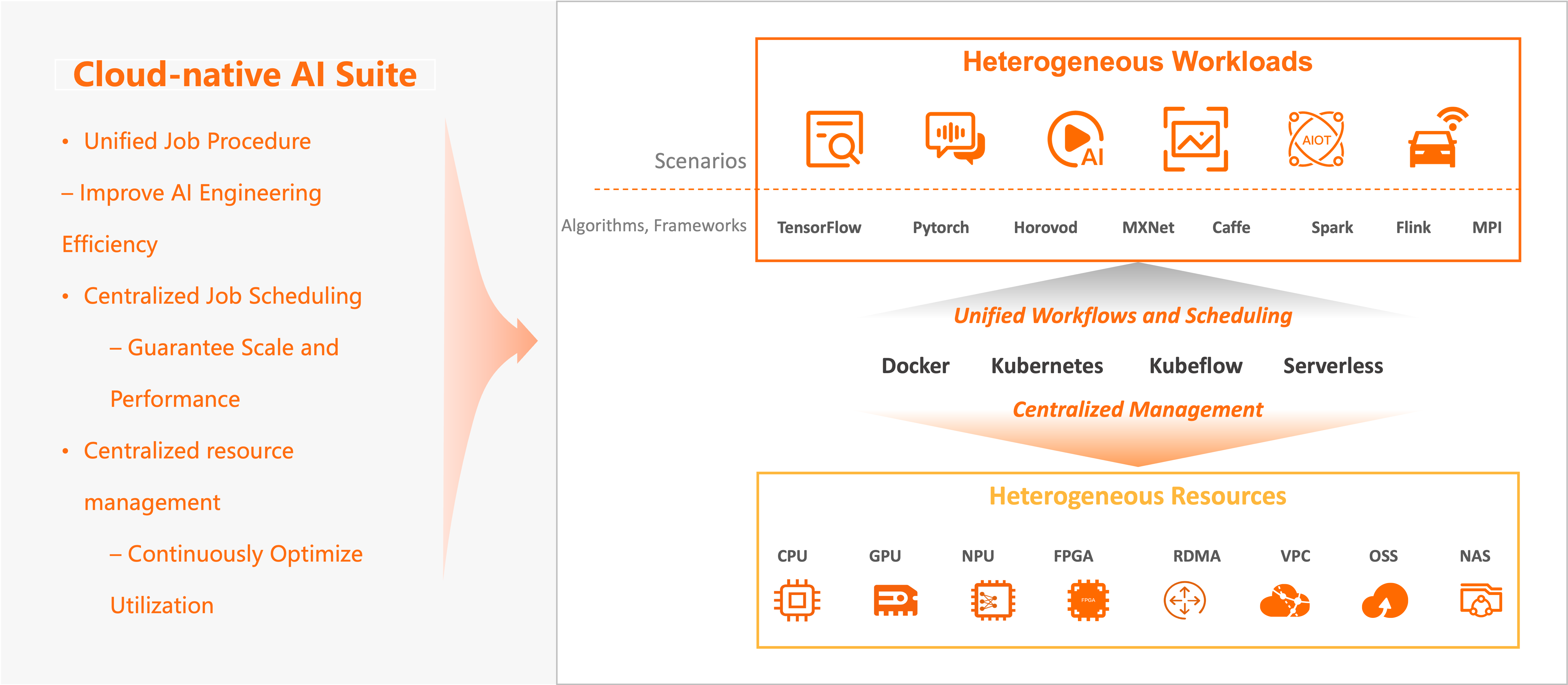クラウドネイティブAIスイートは、クラウドネイティブAIテクノロジーと製品を活用したContainer Service for Kubernetes (ACK) ソリューションです。 クラウドネイティブAIスイートは、クラウドネイティブのアーキテクチャとテクノロジーを最大限に活用して、ACKでAI支援の本番システムを迅速に開発するのに役立ちます。 クラウドネイティブAIスイートは、AIまたは機械学習アプリケーションおよびシステムのフルスタック最適化も提供します。 このトピックでは、クラウドネイティブAIスイートのアーキテクチャ、主要な機能、および使用シナリオについて説明します。 このトピックでは、クラウドネイティブAIスイートを使用する方法についても説明します。
アーキテクチャ
クラウドネイティブAIスイートは、Container Service for Kubernetes (ACK) をベースとして使用します。 異種リソースを一元管理し、主要コンポーネントの実行、リソースの管理と維持、AIジョブのスケジュールとスケーリング、データアクセスの高速化、ワークフローの調整、ビッグデータサービスの統合、AIジョブのライフサイクルの管理、AIアーティファクトの管理、O&Mタスクの実行を行うための標準KubernetesクラスターとAPIを提供します。 クラウドネイティブAIスイートは、AI DevOpsも最適化します。 AIデータセット管理をサポートし、AIモデルを開発、トレーニング、評価し、推論サービスとしてモデルをデプロイできます。
CLI、さまざまなプログラミング言語のSDK、およびコンソールから主要コンポーネントを使用できます。 これらのコンポーネントとツールを使用して、AIプロダクションシステムをオンデマンドで構築、拡張、またはカスタマイズできます。 クラウドネイティブAIスイートでは、同じコンポーネントとツールを使用して、Alibaba cloud AIサービス、オープンソースAIフレームワーク、およびサードパーティAI機能を統合することもできます。
さらに、クラウドネイティブAIスイートは、Platform for AIとのシームレスな統合をサポートし、高性能で弾力性のあるワンストップAIプラットフォームの開発を支援します。 PAIが提供するData Science Workshop (DSW) 、Deep Learning Containers (DLC) 、Elastic Algorithm Service (EAS) などのサービスを使用できます。 ACKは、前述のサービスのAIモデル開発、トレーニング、および推論の弾力性と効率を大幅に向上させることができます。 クラウドネイティブのAIスイートでは、数回クリックするだけで軽量のPlatform for AIをACKクラスターにデプロイし、AI開発をより簡単にすることもできます。 長年の経験に基づいてPAIによって深く最適化されたアルゴリズムとエンジンをコンテナ化されたアプリケーションに統合して、モデルのトレーニングと推論を大幅に高速化できます。 Platform for AIの詳細については、「PAIとは」をご参照ください。
次の図は、クラウドネイティブAIスイートのアーキテクチャを示しています。

主な機能
クラウドネイティブAIスイートは、Kubernetesをベースとして使用し、AIおよび機械学習アプリケーションとシステムのフルスタックサポートと最適化を提供します。 次の表に、クラウドネイティブAIスイートが提供する主な機能を示します。 次の表に、クラウドネイティブAIスイートが提供する主な機能を示します。
機能 | 説明 | 関連ドキュメント |
異種リソースの集中管理 |
| |
AIジョブスケジューリング |
| |
Elasticスケジューリング | 分散深層学習ジョブのElasticスケジューリング: クラウドネイティブAIスイートは、モデルトレーニングとモデル精度に影響を与えることなく、ワーカー数とノード数を動的にスケーリングします。 クラウドネイティブAIスイートは、クラスターにアイドルリソースがある場合はワーカーを追加してトレーニングを高速化し、クラスターが十分なリソースを提供できない場合はワーカーをリリースします。 これにより、モデルトレーニングがリソース不足の影響を受けないようになります。 このモードにより、クラスター全体のリソース使用率が大幅に向上し、ノード障害の回避に役立ちます。 このモードは、ジョブを起動するための待ち時間も短縮します。 | |
AIデータのオーケストレーションと高速化 | 流体: データセットの概念を紹介します。 データ抽象化によるトレーニングジョブを提供し、データセットの管理、アクセス制御の実施、データアクセスの高速化に役立つデータオーケストレーションおよび高速化プラットフォームを提供します。 ack-fluidは、異なるストレージサービスからデータを取り込み、データを同じデータセットに集約できます。 また、ハイブリッドクラウド環境でack-fluidをオンクラウドまたはオンプレミスストレージサービスに接続して、データを管理し、データアクセスを高速化することもできます。 さらに、ack-fluidは、さまざまな分散キャッシュサービスをサポートするように拡張できます。 各データセットにキャッシュサービスを設定し、データセットのウォームアップ、キャッシュ容量の監視、エラスティックスケーリングなどの機能を使用して、トレーニングジョブ用のデータのリモート取り込みのオーバーヘッドを大幅に削減し、GPUコンピューティングの効率を向上させることができます。 | |
AIジョブのライフサイクル管理 |
|
適用シナリオ
クラウドネイティブAIスイートは、異種リソースの利用を継続的に改善し、AIジョブなどの異種ワークロードを効率的に処理するのに適しています。
シナリオ1: 異種リソースの利用を継続的に改善
クラウドネイティブAIスイートは、コンピューティングリソース (CPU、GPU、NPU、VPU、FPGAなど) 、ストレージリソース (OSS、NAS、CPFS、HDFS) 、ネットワークリソース (TCPおよびRDMA) など、クラウド内の異種リソースの抽象化を提供します。 クラウドネイティブAIスイートを使用して、これらのリソースを一元的に管理、維持、割り当てし、リソーススケーリングとソフトウェア /ハードウェア最適化に基づいてリソース使用率を継続的に改善できます。
シナリオ2: AIジョブなどの異種ワークロードを効率的に処理
クラウドネイティブAIスイートは、TensorFlow、PyTorch、DeepSpeed、Horovod、Spark、Flink、Kubeflow、Kserve、vLLM、Triton Inference Serverなどの主流のオープンソースエンジンと互換性があり、セルフマネージドエンジンとランタイムもサポートします。 また、クラウドネイティブAIスイートは、パフォーマンス、効率、コストの面でトレーニングジョブを継続的に最適化し、開発とメンテナンスのユーザーエクスペリエンスを最適化し、エンジニアリング効率を向上させます。 また、クラウドネイティブAIスイートは、パフォーマンス、効率、コストの面でトレーニングジョブを継続的に最適化し、開発とメンテナンスのユーザーエクスペリエンスを最適化し、エンジニアリング効率を向上させます。
ユーザーロール
クラウドネイティブAIスイートは、次のユーザーロールを定義します。
ロール | 説明 |
O&M 管理者 | AIインフラストラクチャの構築と日常管理を担当します。 詳細については、「クラウドネイティブAIスイートのデプロイ」、「ユーザーの管理」、「エラスティッククォータグループの管理」、「データセットの管理」をご参照ください。 |
アルゴリズムエンジニアとデータサイエンティスト | クラウドネイティブAIスイートを使用してジョブを管理します。 詳細については、次をご参照ください: Kubernetesクラスターでのモデルトレーニング、MLflowモデルレジストリでのモデルの管理、モデルの分析と最適化 |
クラウドネイティブAIスイートの操作
次の図の手順に従って、想定しているユーザーロールに基づいてクラウドネイティブAIスイートを使用します。

ステップ | 説明 | コンソール |
1. 準備 (O&M管理者) | Alibaba Cloudアカウントの作成 Alibaba Cloudアカウントを作成し、実名認証を完了します。 詳細については、「Alibaba Cloud アカウントの作成」をご参照ください。 | |
ACKクラスターの作成 ACKを有効にしてACKクラスターを作成します。 次のクラスター設定を使用することを推奨します。 詳細については、「ACK管理クラスターの作成」をご参照ください。
| ||
(オプション) クラスター依存関係の設定と依存クラウドリソースの作成
| ||
2. システムと環境 (O&M管理者) | クラウドネイティブAIスイートの有効化とインストール
| |
ユーザーとクォータの管理
| AIダッシュボードとkubectl | |
データの準備
| ||
(アルゴリズムエンジニアおよびデータサイエンティスト) | クラウドネイティブのAIスイートを使用すると、アルゴリズムエンジニアとデータサイエンティストは、Arena、webコンソール、AI開発者コンソールを使用して、モデルの開発、モデルのトレーニング、推論サービスの展開、ジョブの管理を行うことができます。
| |
3。 モデルトレーニングと展開 (アルゴリズムエンジニアおよびデータサイエンティスト) | ArenaまたはAI開発者コンソールを使用する場合、次の手順を実行してモデルをトレーニングおよびデプロイできます。 開発モデル
鉄道モデル
モデルの管理
モデルのデプロイ モデルを推論サービスとしてデプロイします。 詳細については、次をご参照ください: AIサービスのデプロイ | AI開発者コンソールとアリーナ |
Lightweight Platform for AIを使用して、モデルを開発、トレーニング、デプロイします。 | ||
4。 監視とメンテナンス (O&M管理者) | リソースの監視と保守 クラスター、ノード、トレーニングジョブ、リソースクォータなど、さまざまなリソースのダッシュボードを表示します。 詳細については、「クラウドネイティブAIダッシュボードの操作」をご参照ください。 | |
クォータの管理
| ||
ユーザーの管理 ユーザーまたはユーザーグループを作成、照会、更新、および削除します。 詳細については、「ユーザーの管理」および「ユーザーグループの管理」をご参照ください。 | ||
データセットの管理 | ||
エラスティックジョブの管理 弾性ジョブとジョブの詳細を表示します。 詳細については、「エラスティックジョブの表示」をご参照ください。 | ||
5。 請求と支払い (O&M管理者) | 2024年6月6日の00:00:00 (UTC + 8) 以降、クラウドネイティブAIスイートは無料です。 詳細については、「クラウドネイティブAIスイートの課金」をご参照ください。 | |
請求書を毎日生成する
|
課金ルール
詳細については、「クラウドネイティブAIスイートの課金」をご参照ください。
関連ドキュメント
参照 | 説明 |
クイックスタート (初心者向け) | いくつかのプラクティスを通じて、クラウドネイティブAIスイートを開発およびO&M作業にすばやく適用するのに役立ちます。 詳細については、「クラウドネイティブAIスイートユーザーガイド」および「クラウドネイティブAIスイートの運用およびメンテナンスガイド」をご参照ください。 |
クラウドネイティブAIスイートのリリースノートについて説明します。 |